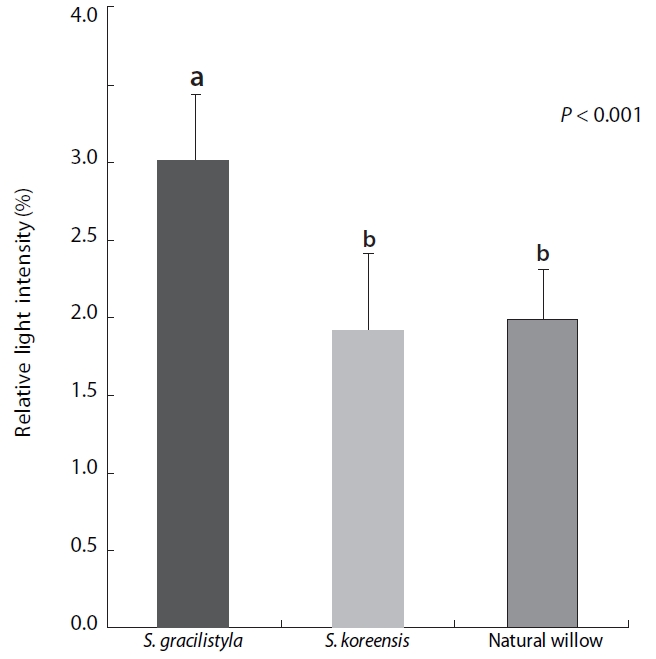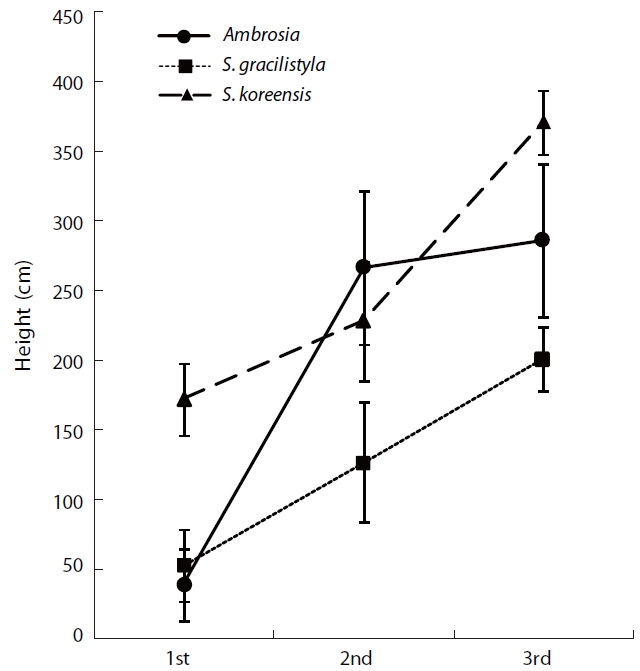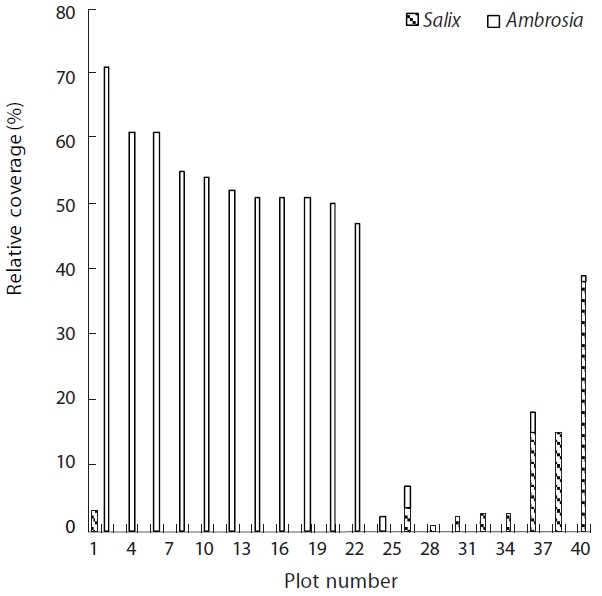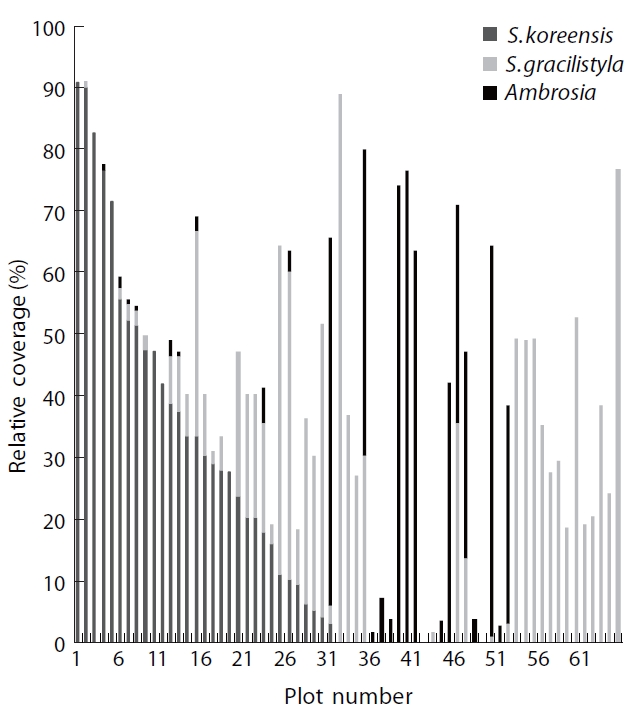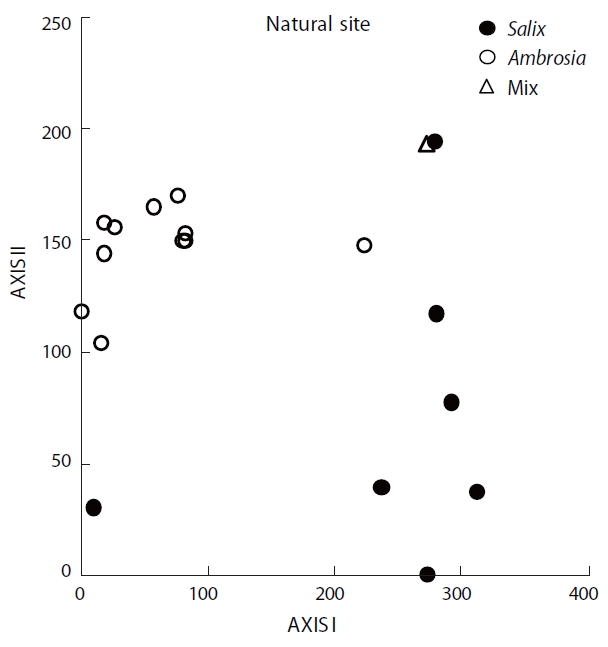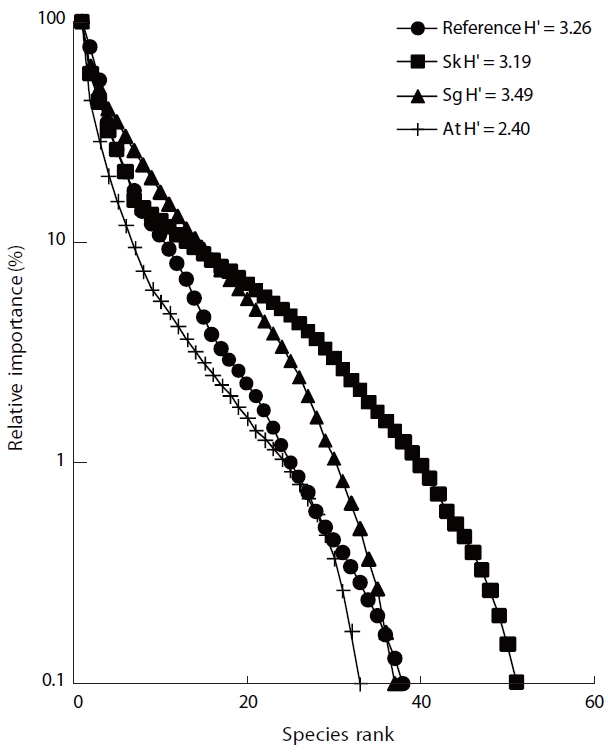



River floodplains and riparian forests throughoutthe world have been modified by human development,inducing losses of biological diversity and ecologicalfunction and increasing the probability of invasion ofinvasive alien species (Naiman et al. 1988, Naiman andDecamps 1990, Petts 1990, National Research Council1992). The need to develop rivers and their water resourcescontinues to intensify owing to the increasingdemands of rapidly growing populations, and the likelyincrease in per capita resource demands. Some species
of flora and fauna have disappeared; exotic species have invaded; the functional characteristics of river systems have been disrupted; and clear reductions in landscape quality and losses of wilderness areas have occurred (Salinas and Guirado 2002).
In Asian countries including Korea where people depend on rice as a food source, most floodplains of rivers were transformed into rice fields in the past. More recently, many rice fields were transformed into urban areas. In such continuing transformation processes, riverside communities have degenerated profoundly or been destroyed by tree cutting, the introduction of exotic species, the diversion and channeling of water for agriculture, and the use of river beds and shores for cultivation or roads. Therefore, riparian landscapes, including a river ecosystem and its surrounding environment, hardly maintain original features (Lee et al. 2005, 2006). In consequence, the riparian zone is known in one of the sites, where the exotic plants appear in the most frequently and vigorously (National Institute of Environmental Research 1995, 1996).
Ambrosia trifida (giant ragweed) is growing along rivers and roads or around agricultural fields (Korean Association for Nature Conservation 1999, Ministry of Environment 2006). In Korea, it was first found near the DMZ, which is located on the central region of the Korean Peninsula. The distributional range of the plant is now expanded from this central region of Korea. The results suggest that this central region played the role of invasion window of the plant in the Korean Peninsula. This plant grows to a stature more than 3 m although it is an herb. This species suppresses other plants in the site that they established, and thereby diminishing biological diversity.
Most studies on the invasive alien species (IAS) carried out in Korea have focused on listing up or describing the distribution range. But the expansion of IAS has already become worldwide problem and the effects of their spread are getting extended (McNeely et al. 2001). This point highlights the urgent need for new approaches to deal with IAS, particularly as a strategy to inhibit new invasion and expansion.
Strategy for invasive alien plant infestations include mowing, herbicide application, grazing, cultivation, burning, shading, flooding, and mechanical barriers (Kim et al. 2006). Giant ragweed grows well in the open spaces without canopy of normal vegetation such as riparian forest. However, the development of a dense canopy of riparian forest can greatly reduce the establishment of giant ragweed. Artificial shading decreased the biomass of exotic plants (Maurer and Zedler 2002, Perry and Galatowitsch 2003) and restorative treatment contributed to reduce biomass of an exotic plant (Kim et al. 2006).
This study aims to clarify restoration effect in terms of the control of the exotic species invasion. In order to confirm the provability, we first carried out a preliminary survey by comparing the abundance of A. trifida between sites with and without Salix spp., dominant species of riparian vegetation in the naturally established vegetation. Furthermore, we practiced a restorative treatment by introducing Salix spp. as the representative element of riparian vegetation and clarified the effect in terms of the inhibition of exotic species invasion by comparing the abundance of the exotic species, species composition, and species diversity between the restored and non-restored sites.
The field survey and experiment were carried out in the Dongmun stream located in Munsan-eub, Paju-si, Gyunggi province in Central Western Korea. “Eub” and “si” are the administrative units, which correspond to “town” and “city”, respectively. Although the bank of the Dongmun stream was covered with concrete blocks, the natural space where willow stand and grassland are interwoven in mosaic pattern, are remained in the rest parts including floodplain remaining in natural state in some areas. Although willow stand and grassland are dominated by Salix koreensis and Phragmites communis, respectively, an invasive alien plant, A. trifida is emerging as a new dominant species as they expand their range rapidly in recent years (Lee et al. 2005, Lee et al. 2007). Experimental restoration was practiced on the bank covered with concrete blocks. Although the old bank, which was constructed several years ago, was covered with A. trifida of dense cover, the newly constructed bank is a barren slope where only herbaceous plants appear sparsely.
The Suip stream, which is located in Bangsan-myun, Yanggu-gun, Gangwon province in eastern Korea (“myun” and “gun” are the administrative units, which correspond to “town” and “county”, respectively) was selected as a reference stream, as the stream was left to follow natural processes for approximately 50 years after the Korean War.
This study was carried out for four years from 2002 to 2005. A preliminary vegetation survey for clarifying the relationship between the representative exotic species of this area, A. trifida and the typical riparian plants, Salix spp. was carried out in 2002 with 20 plots; 10 m × 10 m sized 8 plots for willow dominated stands and 5 m × 5 m sized 12 plots for giant ragweed dominated stands. Restorative treatment by introducing willows to test a hypothesis obtained from the preliminary survey, restoration introducing Salix spp. can control exotic plant such as A. trifida, was practiced in 2002.
The bank of the Dongmun stream was covered with concrete blocks in order to maintain the physical stability of the stream. Treatment for the control of giant ragweed was practiced by introducing two willow species of S. koreensis and Salix gracilistyla to holes (10 cm in diameter, 15 cm in depth) on the concrete blocks. Sample plants cultivated in textile pots (10 cm diameter, 15 cm height) with Terra Cottem as a soil improving gel were planted in holes made at 1 m interval on the concrete block used for waterfront protection. Experimental treatments to clarify the restoration effect were performed in two 50 m × 5 m plots of the restored and the non-restored.
Monitoring for the restoratively treated plots was conducted for three years since the current years of restorative treatment. Monitoring was carried out by measuring the height growth of introduced plants for restoration and exotic plant, giant ragweed, and by surveying vegetation structures including species composition and diversity. The height growth of sample plants was measured with tape ruler with mm-level precision.
The vegetation survey was conducted by the releve method (Barbour et al. 1999). 2 m × 2 m sized quadrats were used for the vegetation survey. All plant species growing in each plot were identified, following Lee (1985), Park (1995), and the Korean Plant Names Index (2003). The survey for monitoring on the restored plots was accomplished in August every year to reduce bias from different survey periods.
The dominance of each species in each plot was estimated by Braun-Blanquet (1964) scale, and each ordinal scale was converted to the median value of the percent cover range in each cover class. The relative coverage (Curtis and McIntosh 1951) determined by multiplying 100 to the fraction of each species cover to the summed cover of all species in each plot was used for comparison and then subjected to Detrended Correspondence Analysis (DCA) (Hill 1979) for ordination with MVSP 3.1 (Kovach 2004). Species diversity was compared using rank-abundance curves, which graphically depict the patterns of species diversity and dominance, and the Shannon Wiever Diversity Index (H’) (Magurran 2003).
Relative light intensity (%) was determined as the percentage of light intensity under vegetation relative to that on the bare ground. The light intensity under vegetation was measured on the herb layer for comparison between the herbaceous and the woody plants-dominated stands. The light intensities were measured with a lux meter (LX-1332; CUSTOM, Tokyo, Japan). Measurements were carried out simultaneously in both sites to reduce variation from measurement time.
Relative light intensity in the naturally established willow stand, which was dominated by S. koreensis, was 1.99 ± 0.33 (%, mean ± SD). The willow stands treated restoratively by introducing S. koreensis was similar to that in the natural willow stand as 1.92 ± 0.50 (%, mean ± SD), whereas that in the stands treated with S. gracilistyla was higher than that as 3.01 ± 0.43 (%, mean ± SD) (Fig. 1).
>
Height of willows and giant ragweed
The heights of giant ragweed measured in August, 2003, 2004, and 2005 were 38.8 ± 25.3, 265.9 ± 54.7, and 285.3 (cm, mean ± SD), respectively. The height of S. koreensis was lower than that of giant ragweed in the second year but surpassed giant ragweed in the third year (Fig. 2). However, the height of S. gracilistyla was lower than that of giant ragweed except for the first year.
>
Relative coverage of willows and giant ragweed
The relative coverage of S. koreensis and A. trifida appeared in 20 quadrats arranged randomly in the naturally established vegetation showed antagonistic distribution depending on the site (Fig. 3). Such a distribution means that both species are in competitive exclusive relationship. From the result of this preliminary survey, we could a provability of controlling A. trifida, a problematic exotic species by introducing willow as a restorative treatment.
On the basis of data collected from the restoratively treated and non-treated sites, the occurrence of S. koreensis, S. gracilistyla and A. trifida were expressed as Fig. 4. Similarly to the result from the naturally established vegetation, the coverage of A. trifida showed the antagonistic distribution to those of Salix spp. From this result,
we could confirm that the restorative treatment played a role in inhibiting the expansion of the exotic species.
As the result of DCA ordination based on the naturally established vegetation, the willow-dominated and the giant ragweed-dominated stands showed clearly segregated distribution with each other, and thereby revealed different species compositions between both stands (Fig. 5).
The result of ordination based on the vegetation data collected from those of the restoratively treated and the non-treated sites, and a reference site, which maintains a relatively healthy state, demonstrated that the treated sites were arranged closer to the reference sites than to the non-treated sites. This result means that restorative treatment caused not only inhibition of expansion of exotic species but also whole change of species composition (Fig. 6).
The species diversity (H’) of the sites restored by introducing S. koreensis and S. gracilistyla was higher than that of the non-restored site dominated by A. trifida (Fig. 7). The species diversity of the restored sites showed similar values to the reference site. On the basis of Shannon-Wiener indices, the species diversity of the sites restored by introducing S. gracilistyla was higher than that of the reference sites but that of sites restored by introducing S. koreensis was lower than that of the reference sites. However, the results based on species rank-dominance curves showed opposite trend (Fig. 7).
Vegetation dominated by the giant ragweed showed differences in terms of both species composition and diversity from the typical riparian vegetation and that restored by introducing willows as dominant species of riparian vegetation (Figs. 5 and 6). These results can be viewed as evidence that the invasion of giant ragweed generally influences on riparian ecosystems. In reality, the giant ragweed produces rhizomes although it is an annual plant, induces shading by extending many branches, and inhibits the establishment of the other plants by
secreting allelochemic substances (Korean Association for Nature Conservation 1999, Ministry of Environment 2006). Therefore, species diversity of the sites that this plant established was quite low (Fig. 7). In addition, the pollen of the plant acts as severe allergy inducing material and thereby causes trouble for humans. Therefore, Ministry of Environment of Korea manages this plant by designating as one of the wild animals and plants, which disturbs ecosystems (Korean Association for Nature Conservation 1999, Ministry of Environment 2006).
In these regards, it is imperative to restore riparian ecosystems, many of which have deteriorated into relatively poor states due to excessive human use (Baird 1989, Berger 1993). Further, our results, which confirmed a provability that restorative treatment by introducing willows results in significant control of the giant ragweed, have significant meaning.
>
Competition between giant ragweed and willows
The giant ragweed typically forms dense stands in open areas such as riparian zones. The plant showed an antagonistic relationship with S. koreensis in zones of naturally established riparian vegetation (Fig. 3). This distributional relationship also remained in the restoratively treated site by introducing willows (Fig. 4).
The relative light intensity on the herb layer of S. koreensis stands was very low as 1.99 ± 0.33% and the giant ragweed appeared there extremely sparsely, if at all. The relative light intensity on the herb layer of stands restored by introducing S. koreensis showed similar values similar to those of the natural stands, but the restored sites by introducing S. gracilistyla showed a little higher than that. The giant ragweed hardly appeared also in the restored sites but the sites restored by introducing S. koreensis suppressed the plant more clearly than those by S. gracilistyla.
The height of S. koreensis grown for three years after introduction was higher than that of the giant ragweed, and thus, could effectively control the plant. However, the height of S. gracilistyla did not grow to the height of the giant ragweed, an herbaceous plant, and thus may difficult to control the plant. Therefore, restoration by introducing trees such as S. koreensis rather than shrubs such as S. gracilistyla would be desirable for the effective control of the giant ragweed.
Willow species were shown in dominant species in the majority of riparian zones in Korea (Lee CS unpublished). Hence, the results of our study point to a successful technique for the management of giant ragweed in riparian sites where willows and giant ragweed co-exist.
>
Restoration as biological control
Invasive species provide a serious challenge to environmental managers because of their explosive growth (Kangas 2004, Correll 2005). The giant ragweed displays vigorous growth and prolific seed production, which facilitates the spread of this species, particularly along river and stream sides, where significant barriers to dispersal may exist. Moreover, the giant ragweed can reach a height of approximately 5 m, even though it is a kind of herbaceous plants (Korean Association for Nature Conservation 1999, Ministry of Environment 2006). Thus, the control of giant ragweed in natural areas has been fairly difficult to achieve. Even though so, our results indicate that restoration by introducing S. koreensis can effectively control the giant ragweed within three growing seasons. Our results suggest that planting of the willow can help restoring riparian areas that have been overtaken by giant ragweed. In addition, willows can function in nurse crop for other understory plants by ameliorating high light, temperature, and soil moisture conditions (Dulohery et al. 2000, McLeod et al. 2001). Willows may benefit the riparian community within and near willows by virtue of such functions. Lower coverage of giant ragweed may continue to increase abundance of other species. The decline in the dominance of giant ragweed owing to willow shading may serve to increase plant diversity in this restored riparian ecosystem. Other riparian woody species may also have a possibility for the control of the giant ragweed by competition. More long-term studies will be necessary to determine whether the willows favor other riparian species over the giant ragweed and examine whether other woody species except willows are effective to manage the giant ragweed
Vegetation dominated by giant ragweed dominated showed different species composition and lower species diversity compared with the typical and the restored riparian vegetation. The coverage of invasive alien plants including the giant ragweed was reduced significantly by a restoration introducing willows. The relative light intensity on the herb layer of S. koreensis stands was quite low and the giant ragweed hardly appeared there. The relative light intensity on herb layer of stands restored by introducing S. koreensis showed values similar to those of the natural stands, but the sites restored by introducing S. gracilistyla showed values slightly higher than that. Giant ragweed hardly appeared also in the restored sites but the sites restored by introducing S. koreensis suppressed the plant more clearly than the sites restored by S. gracilistyla. The height of S. koreensis grown for three years after introduction was higher than that of the giant ragweed, and thus could effectively control the plant. However, the height of S. gracilistyla was lower than that of the giant ragweed, and thus introduction of S. gracilistyla may not be a good method for the control the plant. On the basis of our results, we have concluded that the restoration by introducing trees such as S. koreensis rather than shrubs such as S. gracilistyla would be desirable method for the control of the giant ragweed.
